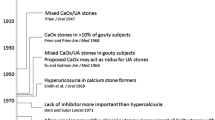Abstract
Idiopathic hypercalciuria is the most important predisposing risk factor for calcium oxalate (CaOx) renal stone formation. We assessed the associations between spontaneous CaOx crystallization based on the Bonn Risk Index (BRI), urinary pH, calciuria, oxaluria, and citraturia in 140 Caucasian patients with hypercalciuria, aged 4–17 years, and compared the findings with those in 210 normocalciuric controls. Of the 140 hypercalciuric patients, 58 had renal stones, and 82 had recurrent erythrocyturia, renal colic, or urinary obstructive symptoms—but without stones. Urinary ionized calcium ([Ca2+]) levels were measured using a selective electrode, while the onset of crystallization was determined using a photometer and titration with 40 mmol/L ammonium oxalate (Ox2−). The calculation of the BRI was based on the [Ca2+]:Ox2− ratio. The BRI values were 12-fold higher in hypercalciuric children than in healthy controls, but no differences were found in the BRI between subjects with urinary stones and those with urolithiasis-like symptoms. An increased BRI suggested an association with hypercalciuria, lower urinary pH, hypocitraturia, and hypooxaluria. These data indicate that hypercalciuria is an important factor associated with increased urinary CaOx crystallization, although the causal pathways need further investigation. Determination of the BRI in children with hypercalciuria may improve the risk assessment of kidney stones.


Similar content being viewed by others
References
VanDervoort K, Wiesen J, Frank R, Vento S, Crosby V, Chandra M, Trachtman H (2007) Urolithiasis in pediatric patients: a single center study of incidence, clinical presentation and outcome. J Urol 177:2300–2305
Srivastava T, Alon US (2007) Pathophysiology of hypercalciuria in children. Pediatr Nephrol 22:1659–1673
Edvardsson V, Elidottir H, Indridason OS, Palsson R (2005) High incidence of kidney stones in Icelandic children. Pediatr Nephrol 20:940–944
Stapleton FB, McKay CP, Noe HN (1987) Urolithiasis in children: the role of hypercalciuria. Pediatr Ann 16:980–992
Alon US, Zimmerman H, Alon M (2004) Evaluation and treatment of pediatric idiopathic urolithiasis—revisited. Pediatr Nephrol 19:516–520
Tiselius HG (1997) Risk formulas in calcium oxalate urolithiasis. World J Urol 15:176–185
Werness PG, Brown CM, Smith LH, Finlayson B (1985) EQUIL 2: a basic computer program for the calculation of urinary saturation. J Urol 34:1242–1244
DeFoor W, Asplin J, Jackson E, Jackson C, Reddy P, Sheldon C, Erhard M, Minevich E (2006) Urinary metabolic evaluations in normal and stone forming children. J Urol 176:1793–1796
Laube N, Schneider A, Hesse A (2000) A new approach to calculate the risk of calcium oxalate crystallization from unprepared native urine. Urol Res 28:274–280
Laube N, Hergarten S, Hesse A (2002) Comparison of a laser-probe and photometric determination of the urinary crystallization risk of calcium oxalate. Clin Chem Lab Med 40:595–599
Laube N, Labedzke V, Hergarten S, Hesse A (2002) Determination of urinary calcium-oxalate formation risk with BONN-Risk-Index and EQUIL applied to a family. J Chem Inf Comput Sci 42:633–639
Lewandowski S, Rodgers AL, Laube N, von Unruh G, Zimmermann D, Hesse A (2005) Oxalate and its handling in a low stone risk vs a stone-prone population group. World J Urol 23:330–333
Porowski T, Zoch-Zwierz W, Konstantynowicz J, Taranta-Janusz K (2008) A new approach to the diagnosis of children’s urolithiasis based on Bonn Risk Index (BRI). Pediatr Nephrol 23:1123–1128
Laube N, Hergarten S, Hoppe B, Schmidt M, Hesse A (2004) Determination of the calcium oxalate crystallization risk from urine samples: the BONN Risk Index in comparison to other risk formulas. J Urol 172:355–359
Kunachowicz H, Nadolna I, Przygoda B (1998) Food composition tables. National Food and Nutrition Institute (PZWL), Warsaw
Battino BS, DeFoor W, Coe F, Tackett L, Erhard M, Wacksman J, Sheldon CA, Minevich E (2002) Metabolic evaluation of children with urolithiasis: are adult references for supersaturation appropriate? J Urol 168:2568–2571
Vezzoli G, Soldati L, Gambaro G (2008) Hypercalciuria revisited: one or many conditions? Pediatr Nephrol 23:503–506
Nordin BE (1959) Assessment of calcium excretion from the urinary calcium/creatinine ratio. Lancet 7099:368–371
Koyun M, Guven AG, Filiz S, Akman S, Akbas H, Baysal YE, Dedeoglu N (2007) Screening for hypercalciuria in schoolchildren: what should be the criteria for diagnosis? Pediatr Nephrol 22:1297–1301
Ghazali S, Barrat TM (1974) Urinary excretion of calcium and magnesium in children. Arch Dis Child 49:97–101
Porowski T, Zoch-Zwierz W, Wasilewska A, Spotyk A, Konstantynowicz J (2007) Normative data on the Bonn Risk Index for calcium oxalate crystallization in healthy children. Pediatr Nephrol 22:514–520
Neuhaus TJ, Belzer T, Blau N, Hoppe B, Sidhu H, Leumann E (2000) Urinary oxalate excretion in urolithiasis and nephrocalcinosis. Arch Dis Child 82:322–326
Moe OW, Preisig PA (2006) Dual role of citrate in mammalian urine. Curr Opin Nephrol Hypertens 15:419–424
Halperin ML, Cheema Dhadli S, Kamel KS (2006) Physiology of acid-base balance: links with kidney stone prevention. Semin Nephrol 26:441–446
Robertson WG, Scurr DS, Bridge CM (1981) Factors influencing the crystallization of calcium oxalate in urine—critique. J Crystal Growth 53:182–194
Acknowledgments
We would like to thank this anonymous reviewer whose supportive comments have helped us develop our thinking in great measure.
Author information
Authors and Affiliations
Corresponding author
Rights and permissions
About this article
Cite this article
Porowski, T., Konstantynowicz, J., Zoch-Zwierz, W. et al. Spontaneous urinary calcium oxalate crystallization in hypercalciuric children. Pediatr Nephrol 24, 1705–1710 (2009). https://doi.org/10.1007/s00467-009-1171-4
Received:
Revised:
Accepted:
Published:
Issue Date:
DOI: https://doi.org/10.1007/s00467-009-1171-4




